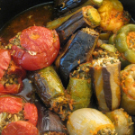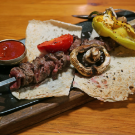
-
Noah’s Ark
Armenians believe that Noah is the ancestor of the Armenian Nation, while their country is the resting place of Noah’s Ark after the great flood.

Human beings have inhabited the Armenian Plateau and the Caucasus region since over 100,000 years ago. Little is known of them, however, drawings in caves and on rocks attest to their existence. The area, situated between some of the Old World’s major water ways, is generally considered as the cradle of civilization. Additionally, the Bible records that Noah’s Ark came to rest on Historic Armenia’s Mt. Ararat, and there are many references of his descent from the mountain after the Great Flood.

-
Traces of Roman Empire
Armenia, as some other areas of the South Caucasus, was part of the Roman Empire. The Temple of Garni, dedicated to the God of the Sun, Mihr (1st century AD), is the only preserved Greco-Roman building in the Caucasus.

The Armenian Apostolic Church is often referred as Gregorian. According to the Armenian Chronicles, St. Gregory was Parthian prince who was educated as a Christian in Cappadocia. He arrived in Armenia in the midst of a Christian persecution and was imprisoned by King Tiradites III in a burial pit. After being rescued, St. Gregory converted the king, and Tiridates III became the first monarch in history to impose Christianity on his people.

-
The First Christian Nation
Armenia was the first country to adopt Christianity, when St. Gregory the Illuminator converted the Arsacid king, Tiradites III. In 301, Christianity was first proclaimed as the official religion. Christianity permeated all aspects of the country’s life and culture.

The Armenian Apostolic Church is often referred as Gregorian. According to the Armenian Chronicles, St. Gregory was Parthian prince who was educated as a Christian in Cappadocia. He arrived in Armenia in the midst of a Christian persecution and was imprisoned by King Tiradites III in a burial pit. After being rescued, St. Gregory converted the king, and Tiridates III became the first monarch in history to impose Christianity on his people.

-
Khachkars Cross Stones
Armenian Khachkars, or Cross Stones, are memorial steles with an ornamentally carved cross in the middle, resting on the symbol of a sun or wheel of eternity, accompanied by vegetative-geometric motifs and carvings of saints and animals.

Armenian Cross Stones have a particular meaning and importance for locals: After being blessed and anointed, the Khachkar is believed to possess holy powers and can provide help, protection, victory, long life, remembrance, and mediation towards salvation of the soul. There are over 50,000 Khachkars in Armenia, each is unique and has its own pattern. The largest accumulation of Khachkars can be seen on the cemetery of Noradus, often called the Field of Khachkars.

-
- Eshkhemed
- Hovern Egan
- Mirzayi
- Gladiator Theme Music
- Shalakho
Duduk - Armenian Oboe
The roots of Armenian duduk music go back tothe ancient times and during the turbulent history of the country it was part of Armenians’ everyday life, in joy and in sorrow.


The Armenian oboe, or Armenian Duduk, is a double reed wind instrument characterized by a warm, soft, slightly nasal timbre. Its roots go as far back as the 1st cent. BC. It accompanies popular Armenian traditional songs and dances. It is always played at the most important events of human life, such as weddings and funerals. The Duduk and its music are listed as Intangible Cultural Heritage by UNESCO.


-
Armenian Brandy
Ararat is an Armenian brandy that has been produced by the Yerevan Brandy Company since 1887. It is made from Armenian white grapes and spring water, according to a traditional method.

Armenian brandy, or Armegnac, is the part of Armenian cultural and the historical heritage. Only local varieties of grape with special properties are used in the production of authentic Armenian brandy, based on the unique microclimate of the Ararat Valley.


A Selection of Armenian Cuisine
Armenian cuisine is like a poem, each line of which has its own aroma and reminds you of innumerable dinners of shepherds and monks. Travel in Armenia, taste the local dishes and get acquainted with the history of Armenian cognac distillation, as well as taste this sunlit spirit.
A Selection of Armenian Cuisine
-

Dolma
One of the main dishes of Armenian cuisine, which is rolled in the leaves of grape and served with stand-alone matsun (Armenian yogurt) poured over it.
-

Khorawats
It is good at any season of the year. In the summertime, Khorovats is usually served with tomatoes, eggplant and bell peppers baked on skewers over hot coals.
-

Armenian Lavash
Even when abroad, Armenians remember about their traditional bread, Lavash. Real Lavash is a very thin, lightly wrapped strip of dough about one meter long, baked on the hot wall of the oven, or tondir. Taste it with traditional Armenian cheese and greens, which are staples of every dinner.
-

Basturma
Basturma is an air-cured and spiced product made from the topside of beef to recipes dating back to pre-Christian times. Basturma is prepared by salting the meat, then washing it with water and letting it dry for 10–15 days.
-

Kyata and Nazuk
The most known sweets are Kyata and Nazuk – original multi-layered pies with stuffing. Each layer is soaked with drawn butter and sugar. As a result, Kyata and Nazuk have a melting dough and mild taste.
Armenian cuisine is like a poem, each line of which has its own aroma and reminds you of innumerable dinners of shepherds and monks. Travel in Armenia, taste the local dishes and get acquainted with the history of Armenian cognac distillation, as well as taste this sunlit spirit.
“Never be late for dinner, smoke Havana cigars, and drink Armenian Cognac.” - Sir Winston Churchill

Mt. Ararat view, Khor Virap

Khor Virap Monastery

Zvartnots Cathedral (7th C)

Noravank Monastery (7th C)

Sevanavank Monastery Complex (9th C)

Noraduz , “Forest Kashkars” (cross-stones)

Republic Square, Yerevan

Armenia Brandy tasting

View from Cascade Stairs, Yerevan
… one of the oldest nations in the world
A country with an ancient history, rich culture, friendly and hospitable people,
thousands of historical and architectural monuments, healthy and delicious food.
There is something dramatically beautiful in the Armenian nature and culture: the deep blue sky, red fields of poppies, impressive cultural heritage that survived the turbulent history of the country…
CLICK TO SEE OUR MOST WANTED TOURS EXPLORING ARMENIA












